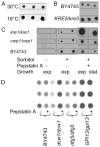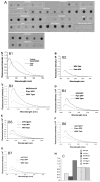A screen for deficiencies in GPI-anchorage of wall glycoproteins in yeast
- PMID: 20602336
- PMCID: PMC3050522
- DOI: 10.1002/yea.1797
A screen for deficiencies in GPI-anchorage of wall glycoproteins in yeast
Abstract
Many of the genes and enzymes critical for assembly and biogenesis of yeast cell walls remain unidentified or poorly characterized. Therefore, we designed a high throughput genomic screen for defects in anchoring of GPI-cell wall proteins (GPI-CWPs), based on quantification of a secreted GFP-Sag1p fusion protein. Saccharomyces cerevisiae diploid deletion strains were transformed with a plasmid expressing the fusion protein under a GPD promoter, then GFP fluorescence was determined in culture supernatants after mid-exponential growth. Variability in the amount of fluorescent marker secreted into the medium was reduced by growth at 18 degrees C in buffered defined medium in the presence of sorbitol. Secondary screens included immunoblotting for GFP, fluorescence emission spectra, cell surface fluorescence, and cell integrity. Of 167 mutants deleted for genes affecting cell wall biogenesis or structure, eight showed consistent hyper-secretion of GFP relative to parental strain BY4743: tdh3 (glyceraldehyde-3-phosphate dehydrogenase), gda1 (guanosine diphosphatase), gpi13 and mcd4 (both ethanolamine phosphate-GPI-transferases), kre5 and kre1 (involved in synthesis of beta1,6 glucan), dcw1(implicated in GPI-CWP cross-linking to cell wall glucan), and cwp1 (a major cell wall protein). In addition, deletion of a number of genes caused decreased secretion of GFP. These results elucidate specific roles for specific genes in cell wall biogenesis, including differentiating among paralogous genes.
Copyright (c) 2010 John Wiley & Sons, Ltd.
Figures





References
-
- Aanen DK, Slippers B, Wingfield MJ. Biological pest control in beetle agriculture. Trends Microbiol. 2009;17:179–182. - PubMed
-
- Adesemoye AO, Kloepper JW. Plant–microbes interactions in enhanced fertilizer-use efficiency. Appl Microbiol Biotechnol. 2009;85:1–12. - PubMed
-
- Alloush HM, Lopez-Ribot JL, Masten BJ, et al. 3-Phosphoglycerate kinase: a glycolytic enzyme protein present in the cell wall of Candida albicans. Microbiology. 1997;143(2):321–330. - PubMed
-
- Almeida AM, Hillmen P, Richards SJ, et al. Defective modification of mannose residues by terminal phosphoethanolamine underlies inherited GPI deficiency. J Am Soc Hematol. 2005;106 abstr 128.
Publication types
MeSH terms
Substances
Grants and funding
LinkOut - more resources
Full Text Sources
Other Literature Sources
Molecular Biology Databases
Research Materials
